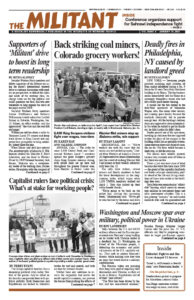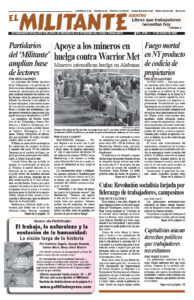Talks between the U.S.-led NATO military alliance and the Russian government over Moscow’s troop buildup on its border with Ukraine ended in a deadlock Jan. 13. Washington, no friend of the Ukrainian people, is defending the economic and political interests of the U.S. capitalist rulers. They seek to contain Moscow’s threats, while making sure they take no steps that would lead to a military confrontation.
The Russian rulers are pursuing their long-term goal of imposing their domination over Ukraine, as they act to do in Belarus, Kazakhstan and all of their “near abroad.”
“The West has been driven by hubris and has exacerbated tensions,” Russian Foreign Minister Sergey Lavrov told the press Jan. 14. U.S. officials say they’re preparing sanctions to target pro-Russian separatists in Ukraine but will not sanction Moscow yet. But they threaten to do so if there is Russian military action against Ukraine.
Over three decades the U.S. rulers have extended their vast armed might closer and closer to the borders of Russia, acting on the illusion they’d won the Cold War when the Stalinist regimes in the former Soviet Union crumbled. Washington brought former Soviet bloc countries into NATO and set up missile defense systems in Poland and Romania. NATO established rotating forces in Estonia, Latvia, Lithuania and Poland.
Russian President Vladimir Putin says reclaiming Russia’s “sphere of influence” is his central foreign policy goal. He laments the breakup of what he calls “historical Russia,” as “the greatest geopolitical tragedy of the 20th century.” During the talks Lavrov demanded that NATO pledge not to station its forces in Ukraine or other ex-Soviet nations.
After the talks, a Kremlin representative provocatively proposed Moscow counter NATO’s expansion by deploying its own missiles on the territory of Latin American governments that have close relations with the Russian rulers.
The day after the talks began, some of the 100,000-plus Russian troops stationed along the border with Ukraine began conducting live-fire drills with tanks. Moscow has transferred trainloads of weaponry from its bases in the east to its western borders.
Putin insists the buildup is in response to threats by the Ukrainian army against Moscow-backed separatist forces in eastern Ukraine. His aim is to pressure the Ukrainian rulers to end moves toward closer relations with imperialist governments in Europe and the U.S.
In 2014, protests in Ukraine, involving more than a million workers, farmers and youth for months, overthrew the pro-Moscow regime of President Viktor Yanukovych. Thousands camped for weeks in the Maidan — Independence Square — in the capital, Kyiv, inspiring protests across the country and defiantly fighting off murderous attacks by riot police.
Moscow responded to the ousting of Yanukovych by arming pro-Russia separatists in eastern Ukraine in a war over the rich industrial Donbas region. It also seized and occupied Ukraine’s Crimea Peninsula, dealing blows to the Crimean Tartar population and to Ukrainian sovereignty. Over eight years more than 14,000 Ukrainians have been killed in the periodic fighting, with millions displaced.
Disarray in imperialist alliance
Despite being members of NATO, governments in the European Union took no part in the NATO-Moscow talks. This reflected the “hollowness of the European Union’s actual weight in a world of hard power,” Steven Erlanger wrote in the Jan. 10 New York Times.
Top EU bureaucrats complained at being left out of the talks. Earlier, the French and German governments had sent their own emissaries to Moscow for separate negotiations. The Ukrainian government was not invited to be part of any of these discussions.
There is a rift between the U.S. and German rulers, including over the German government’s decision to import natural gas from Russia through Moscow’s Nord Stream 2 gas pipeline. It bypasses an earlier pipeline through Ukraine, another way for Moscow to squeeze Ukrainian sovereignty. It will increase the dependency of the German and other EU governments on gas supplies from Russian companies, which Moscow can use to exert political pressure on the German rulers.
This question has split the new Social Democrat-Greens governing coalition in Berlin. Washington wants Berlin to threaten to shelve the pipeline if Moscow’s forces were to attack Ukraine. Germany’s new foreign minister, Annalena Baerbock of the Green Party, agrees.
But the Social Democrats who head the governing coalition favor an arrangement with Moscow, saying Russian gas supplies are key for industrial production. With weaker armed forces of their own, Germany’s capitalist rulers find themselves forced to tack between Moscow and Washington to defend their interests.
President Joseph Biden is trying to pull the U.S. rulers’ imperialist allies behind his threats of tougher economic action, hoping to deter Moscow. This is part of Washington’s wider efforts to shore up alliances as it faces sharpening conflicts today with the rulers of China, especially, but also Russia, for markets, resources and investment.
Moscow’s threats against Ukraine come alongside its recent intervention in Kazakhstan, helping repress massive anti-government protests, and its backing to the regime of President Alexander Lukashenko in Belarus that in 2020 suppressed working people and youth fighting for political rights. The Russian rulers fear the example these struggles can have on millions devastated by the capitalist crisis in Russia.

